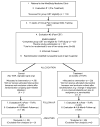Therapeutic Interactive Voice Response for chronic pain reduction and relapse prevention
- PMID: 18178011
- PMCID: PMC2693197
- DOI: 10.1016/j.pain.2007.11.001
Therapeutic Interactive Voice Response for chronic pain reduction and relapse prevention
Abstract
We developed Therapeutic Interactive Voice Response (TIVR) as an automated, telephone-based tool for maintenance enhancement following group cognitive-behavioral therapy (CBT) for chronic pain. TIVR has four components: a daily self-monitoring questionnaire, a didactic review of coping skills, pre-recorded behavioral rehearsals of coping skills, and monthly personalized feedback messages from the CBT therapist based on a review of the patient's daily reports. The first three components are pre-recorded and all four can be accessed remotely by patients via touch-tone telephone on demand. Following 11 weeks of group CBT, 51 subjects with chronic musculoskeletal pain were randomized to one of two study groups. Twenty-six subjects participated in 4 months of TIVR, while a control group of 25 subjects received standard care only. The TIVR group showed maximum improvement over baseline at the 8-month follow-up for seven of the eight outcome measures; improvement was found to be significant for all outcomes (p<or=001). Between-group analysis of covariance (ANCOVA) revealed significantly greater improvement for the experimental group at both 4- and 8-month follow-ups for most of the outcomes. Results demonstrate that TIVR can be used to decrease pain, improve coping and decrease likelihood of relapse into pain behavior. Preliminary analysis of medication usage suggests that the superior outcome of the TIVR group was unlikely to be a consequence of differential medication use.
Figures





Comment in
-
Relapse prevention: still neglected after all these years.Pain. 2008 Feb;134(3):239-240. doi: 10.1016/j.pain.2007.12.004. Epub 2007 Dec 27. Pain. 2008. PMID: 18164134 No abstract available.
-
Therapeutic Interactive Voice Response enhanced CBT gains in chronic pain.Evid Based Nurs. 2008 Jul;11(3):79. doi: 10.1136/ebn.11.3.79. Evid Based Nurs. 2008. PMID: 18583491 No abstract available.
Similar articles
-
Therapeutic Interactive Voice Response (TIVR) to reduce analgesic medication use for chronic pain management.J Pain. 2010 Dec;11(12):1410-9. doi: 10.1016/j.jpain.2010.03.019. J Pain. 2010. PMID: 20620119 Free PMC article. Clinical Trial.
-
Automated telephone as an adjunct for the treatment of chronic pain: a pilot study.J Pain. 2002 Dec;3(6):429-38. doi: 10.1054/jpai.2002.129563. J Pain. 2002. PMID: 14622728
-
Interactive Voice Response-Based Self-management for Chronic Back Pain: The COPES Noninferiority Randomized Trial.JAMA Intern Med. 2017 Jun 1;177(6):765-773. doi: 10.1001/jamainternmed.2017.0223. JAMA Intern Med. 2017. PMID: 28384682 Free PMC article. Clinical Trial.
-
[Can we do therapy without a therapist? Active components of computer-based CBT for depression].Encephale. 2017 Dec;43(6):582-593. doi: 10.1016/j.encep.2016.08.006. Epub 2016 Oct 10. Encephale. 2017. PMID: 27745720 Review. French.
-
Do the effects of internet-delivered cognitive-behavioral therapy (i-CBT) last after a year and beyond? A meta-analysis of 154 randomized controlled trials (RCTs).Clin Psychol Rev. 2024 Dec;114:102518. doi: 10.1016/j.cpr.2024.102518. Epub 2024 Nov 16. Clin Psychol Rev. 2024. PMID: 39579466 Free PMC article. Review.
Cited by
-
Psychological approaches to understanding and treating arthritis pain.Nat Rev Rheumatol. 2010 Apr;6(4):210-6. doi: 10.1038/nrrheum.2010.22. Nat Rev Rheumatol. 2010. PMID: 20357790 Review.
-
A Clinical Trial of a Program for Pain Management and Opioid Reduction During Pregnancy.Reprod Sci. 2022 Feb;29(2):606-613. doi: 10.1007/s43032-021-00701-4. Epub 2021 Aug 17. Reprod Sci. 2022. PMID: 34403125 Clinical Trial.
-
Recruiting 9126 Primary Care Patients by Telephone: Characteristics of Participants Reached on Landlines, Basic Cell Phones, and Smartphones.Popul Health Manag. 2016 Jun;19(3):212-5. doi: 10.1089/pop.2015.0047. Epub 2015 Sep 8. Popul Health Manag. 2016. PMID: 26348723 Free PMC article.
-
Digital Health Interventions for Musculoskeletal Pain Conditions: Systematic Review and Meta-analysis of Randomized Controlled Trials.J Med Internet Res. 2022 Sep 6;24(9):e37869. doi: 10.2196/37869. J Med Internet Res. 2022. PMID: 36066943 Free PMC article.
-
Maintenance of treatment gains from psychological treatments for chronic pain: what (little) we know, and the urgent need to extend it.Pain. 2025 Mar 11:10.1097/j.pain.0000000000003552. doi: 10.1097/j.pain.0000000000003552. Online ahead of print. Pain. 2025. PMID: 40085755 Free PMC article. No abstract available.
References
-
- Baer L, Greist JH. An interactive computer-administered self-assessment and self-help program for behavior therapy. J Clin Psychiatry. 1997;58:23–28. - PubMed
-
- Basler HD. Group treatment for pain and discomfort. Patient Educ Couns. 1993;20:167–175. - PubMed
-
- Basler HD, Jakle C, Kroner-Herwig B. Incorporation of cognitive-behavioral treatment into the medical care of chronic low back patients: A controlled randomized study in German pain treatment. Patient Educ Couns. 1997;31:113–124. - PubMed
-
- Compas BE, Haaga DAF, Keefe FJ, Leitenberg H, Williams DA. A sampling of empirically supported psychological treatments from health psychology: Smoking, chronic pain, cancer, & bulimia nervosa. J Consult Clin Psychol. 1998;66:89–112. - PubMed
-
- Connally GH, Sanders SH. Predicting low back pain patients’ response to lumbar sympathetic nerve blocks and interdisciplinary rehabilitation: The role of pretreatment overt pain behavior and cognitive coping strategies. Pain. 1991;44:139–146. - PubMed
Publication types
MeSH terms
Grants and funding
LinkOut - more resources
Full Text Sources
Medical

